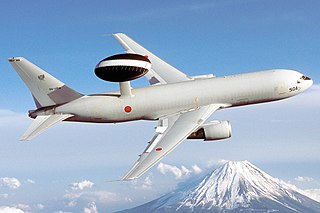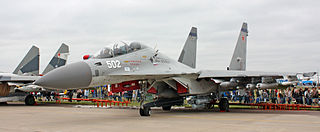Related Research Articles

The Grumman A-6 Intruder is an American twinjet all-weather attack aircraft developed and manufactured by American aircraft company Grumman Aerospace and formerly operated by the U.S. Navy and U.S. Marine Corps.

The Raytheon MIM-23 HAWK is an American medium-range surface-to-air missile. It was designed to be a much more mobile counterpart to the MIM-14 Nike Hercules, trading off range and altitude capability for a much smaller size and weight. Its low-level performance was greatly improved over Nike through the adoption of new radars and a continuous wave semi-active radar homing guidance system. It entered service with the US Army in 1959.

The AN/MPQ-64 Sentinel is an X-band electronically steered pulse-Doppler 3D radar system used to alert and cue Short Range Air Defense (SHORAD) weapons to the locations of hostile targets approaching their front line forces. It is currently produced by Raytheon Missiles & Defense.

The AN/APG-63 and AN/APG-70 are a family of all-weather multimode radar systems designed by Hughes Aircraft for the F-15 Eagle air superiority fighter. These X band pulse-Doppler radar systems are designed for both air-air and air-ground missions; they are able to look up at high-flying targets and down at low-flying targets without being confused by ground clutter. The systems can detect and track aircraft and small high-speed targets at distances beyond visual range down to close range, and at altitudes down to treetop level. The radar feeds target information into the aircraft's central computer for effective weapons delivery. For close-in dogfights, the radar automatically acquires enemy aircraft and projects this information onto the cockpit head-up display. The name is assigned from the Army Navy Joint Electronics Type Designation System.

The AN/APQ-181 is an all-weather, low probability of intercept (LPI) phased array radar system designed by Hughes Aircraft for the U.S. Air Force B-2A Spirit bomber aircraft. The system was developed in the mid-1980s and entered service in 1993. The APQ-181 provides a number of precision targeting modes, and also supports terrain-following radar and terrain avoidance. The radar operates in the Ku band. The original design uses a TWT-based transmitter with a 2-dimensional passive electronically scanned array (PESA) antenna.
The AN/APQ-174 is an American Ku band radar used on military helicopters for navigation, particularly at low level.

The AN/AWG-9 and AN/APG-71 radars are all-weather, multi-mode X band pulse-Doppler radar systems used in the F-14 Tomcat, and also tested on TA-3B. It is a long-range air-to-air system capable of guiding several AIM-54 Phoenix or AIM-120 AMRAAM missiles simultaneously, using its track while scan mode. The AWG-9 utilizes an analog computer while the APG-71 is an upgraded variant utilizing a digital computer. Both the AWG-9 and APG-71 were designed and manufactured by Hughes Aircraft Company's Radar Systems Group in Los Angeles; contractor support was later assumed by Raytheon. The AWG-9 was originally created for the canceled Navy F-111B program.
AN/APQ-116 is one of the most numerous terrain-following radars (TFRs) produced in the world, and with over 500 units built, it was a member of a family of TFRs consisted of nearly two dozen models, all of which are based on the same general design principle. First developed by Texas Instruments, and later produced by Raytheon when the latter purchased the radar business of the former.

An airport surveillance radar (ASR) is a radar system used at airports to detect and display the presence and position of aircraft in the terminal area, the airspace around airports. It is the main air traffic control system for the airspace around airports. At large airports it typically controls traffic within a radius of 60 miles (96 km) of the airport below an elevation of 25,000 feet. The sophisticated systems at large airports consist of two different radar systems, the primary and secondary surveillance radar. The primary radar typically consists of a large rotating parabolic antenna dish that sweeps a vertical fan-shaped beam of microwaves around the airspace surrounding the airport. It detects the position and range of aircraft by microwaves reflected back to the antenna from the aircraft's surface. The secondary surveillance radar consists of a second rotating antenna, often mounted on the primary antenna, which interrogates the transponders of aircraft, which transmits a radio signal back containing the aircraft's identification, barometric altitude, and an emergency status code, which is displayed on the radar screen next to the return from the primary radar.
The AN/APG-76 radar is a pulse Doppler Ku band multi-mode radar developed and manufactured by Northrop Grumman.

The Boeing E-767 is an Airborne Warning and Control System (AWACS) aircraft that was designed in response to the Japan Air Self-Defense Force's requirements. It is essentially the Boeing E-3 Sentry's surveillance radar and air control system installed on a Boeing 767-200.

The KLJ-7, also referred to as the Type 1478, is an X band airborne fire-control radar (FCR) developed by Nanjing Research Institute of Electronic Technology (NRIET), also known as the China Electronics Technology Company's (CETC's) No. 14 Research Institute. In December 2010, Pakistan Air Force's Air Chief Marshal Rao Qamar Suleman announced that KLJ-7 radar will be built at Pakistan Aeronautical Complex (PAC), in Kamra, north of Islamabad.

N001 Mech is a Russian all-weather multimode airborne radar developed by the Tikhomirov Scientific Research Institute of Instrument Design (NIIP) for the Su-27 multi-role combat aircraft.

The Emerson Electric AN/APQ-153 was an I band radar system developed for the Northrop F-5E fighter aircraft. Required to fit into the tight confines of the originally radar-less F-5, the system offered relatively simple air-to-air modes and a short detection range. The AN/APQ-157 was a similar system with dual displays and controls for the twin-seat F-5F trainer. Many of the F-5s still flying have been upgraded to the improved AN/APQ-159.
Emerson Electric's AN/APG-69 is an X band coherent pulse doppler radar originally designed for the F-20 Tigershark aircraft. It is the successor to the AN/APQ-159. Northrop skipped over the APG-69 for the F-20, choosing the General Electric AN/APG-67 instead. The APG-69 was still used by other F-5 operators, and other light fighter projects, including the ALR Piranha.
The AN/APG-67 is a multi-mode all-digital X band coherent pulse doppler radar originally developed by General Electric for the Northrop F-20 Tigershark program of the early 1980s. It offers a variety of air-to-air, air-to-ground, sea-search and mapping modes, and compatibility with most weapons used by the US Air Force in the 1980s.

The AN/APQ-120 was an aircraft fire control radar (FCR) manufactured by Westinghouse for the McDonnell Douglas F-4E Phantom II. AN/APQ-120 has a long line of lineage, with its origin traced all the way back to Aero-13 FCR developed by the same company in the early 1950s. A total of half a dozen FCRs were tested and evaluated on the first 18 F-4s built, but they were soon replaced by later radars produced in great numbers, including AN/APQ-120.

Aircraft interception radar, or AI radar for short, is a British term for radar systems used to equip aircraft with the means to find and track other flying aircraft. These radars are used primarily by Royal Air Force (RAF) and Fleet Air Arm night fighters and interceptors for locating and tracking other aircraft, although most AI radars could also be used in a number of secondary roles as well. The term was sometimes used generically for similar radars used in other countries, notably the US. AI radar stands in contrast with ASV radar, whose goal is to detect ships and other sea-surface vessels, rather than aircraft; both AI and ASV are often designed for airborne use.
The Grifo radar is a family of airborne radars developed by Italian firm Leonardo S.p.A. for fighter aircraft and attack aircraft, and this family of radars includes several series.
References
- ↑ Jane's Avionics, 1991-92 edition, Jane's Information Group, 1991. ISBN 9780710609663
- ↑ APQ-167 on T-47